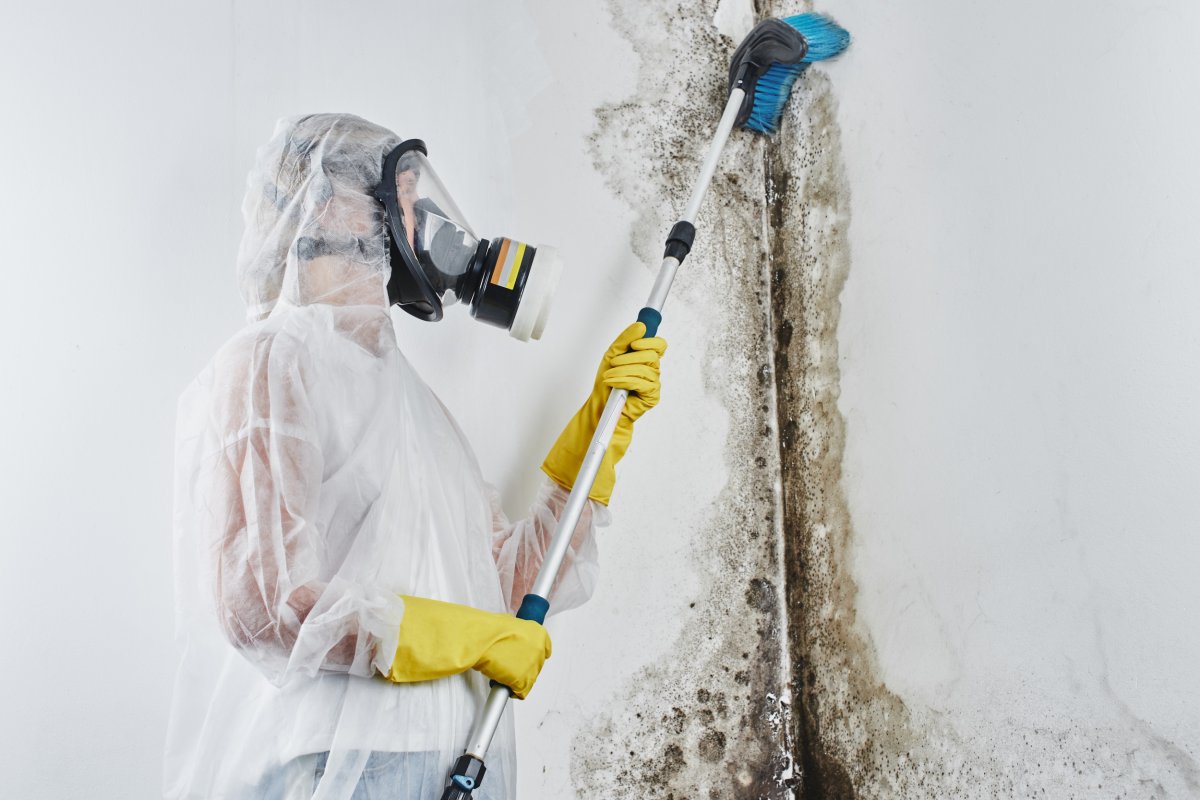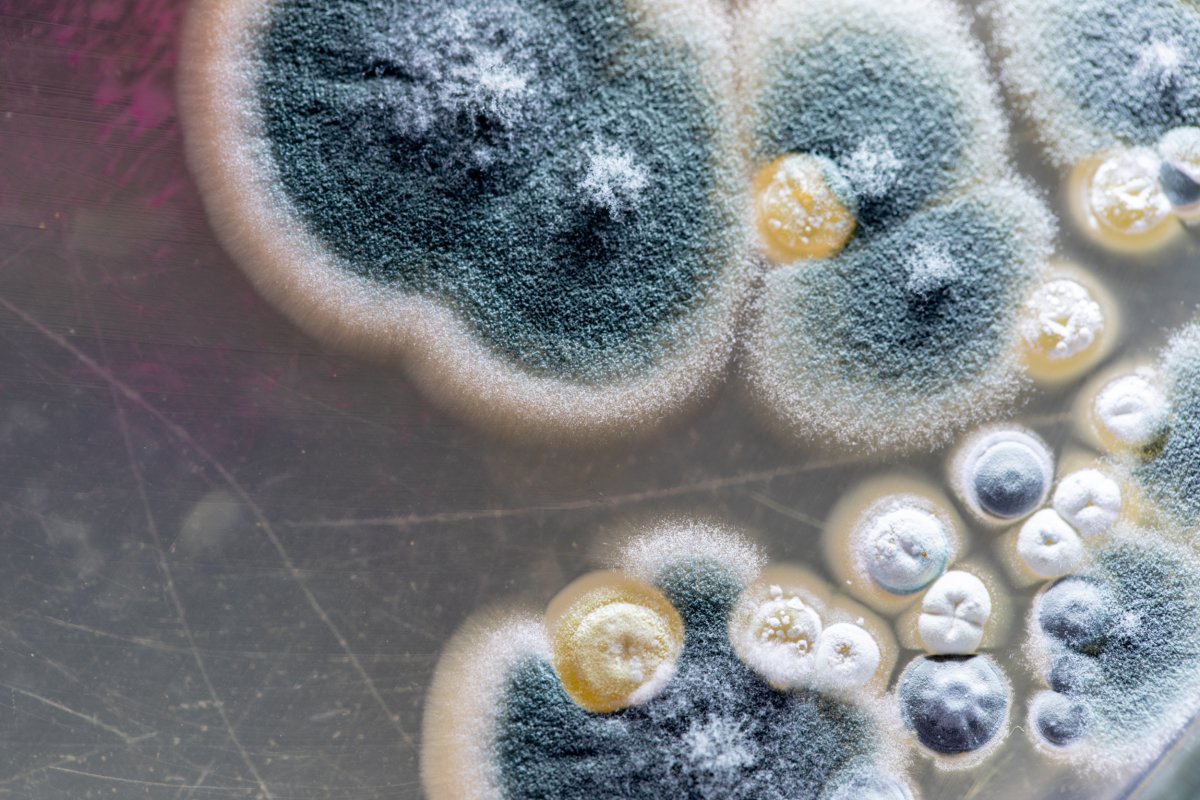Black mold is very common in buildings and homes, especially around this time of the year, and it can be extremely hard to remove. It grows in places where there is a lot of moisture, such as windows and pipes, around leaks in roofs or where there has been flooding.
Besides being unpleasant to look at, mold can also cause many health problems. People with asthma or who are allergic to mold may have severe reactions, and immune-compromised people, as well as people with chronic lung disease, can develop lung infections.
To avoid mold, humidity levels at home should be kept between 30 percent and 50 percent, rooms should be ventilated and leaks should be addressed. If your home has been infested by mold and you're struggling to clean it up, these top tips by professional cleaners may help.

Is Black Mold Dangerous?
According to the Centers for Disease Control and Prevention, exposure to damp and moldy environments can cause a variety of health problems, including symptoms such as a stuffy nose, wheezing, and red or itchy eyes or skin.
Severe reactions may also occur among workers who are exposed to large amounts of mold in occupational settings, for example, farmers working around moldy hay. These reactions can include fever and shortness of breath.
On Tuesday, a British coroner established that mold caused the death of Awaab Ishak, who died shortly after his second birthday in December 2020, because of a severe respiratory condition caused by prolonged exposure to mold in his home.
How To Eliminate Black Mold
Mold spores can be found nearly everywhere and when they are exposed to moderate temperatures and moisture they begin to grow and multiply. Since it is not generally feasible to eliminate mold, professional cleaners aim to reduce the moisture exposure that allows mold spores to proliferate.
1. Identify the Source
Before cleaning any mold you must identify the source because if the mold is cleaned up but the water source is not found it will return.
Mike Powell owner of Red Flag Home Inspection told Newsweek that if mold is very dense, you are likely dealing with direct wetting. This could be a pipe leak, a failed drain line beneath a sink, a window leak or roof damage. If less dense, you are either dealing with humidity (airborne moisture) or a lesser volume water event. Either way, the source needs to be found and eliminated prior to proceeding.
2. Protect Yourself—Wear a Mask, Goggles and Gloves
When dealing with black mold you must ensure you're properly protected, which means you'll need a respirator to protect you against spores, as well as clothing that covers all skin. You'll also need to use safety goggles and rubber gloves throughout the entire process.
3. Prep Affected Areas
Another important step before cleaning is to ensure your air conditioning, and/or heater are off, to prevent moving air from transporting spores while cleaning. You should also seal any doorways that lead out of the room to keep mold spores trapped inside, and open all windows, using an exhaust fan near openings to the outdoors, to funnel air outside of the home.

4. Clean Up the Mold
Once the room is prepped, you can spray the black mold with either a natural or chemical-based mold remover and let it sit for 30 minutes to an hour, Andrii Gurskyi co-founder of HomeClean cleaning services told Newsweek. It can then be scrubbed with a sponge and additional cleaning solution. Once dry, repeat the process as many times as you need to altogether remove the mold.
5. Discard ALL Products Used To Clean Up Mold
When you're done with the scrubbing, thoroughly clean the area by removing any dirt or debris that could contain additional mold, making sure to clean the entire room before you unseal your doorways, leaving the exhaust fan on for 12-24 hours to ensure any airborne spores are gone.
According to Powell, other ways to clean up mold are to vacuum surfaces or clean them using a quart of water and a half cup of bleach.
He said: "Many also recommend using vinegar, which is OK, but please note that bleach and vinegar create a toxic vapor when mixed, so do not use both! This mixture [of either water and bleach or water and vinegar] can be used to scrub the mold, with a sponge or scrubbing pad, until you cannot see the mold or staining.
"If [any] visible discoloration remains, this is likely due to the hyphae (rooting structure of mold) embedded within the material. No amount of scrubbing may remove discoloration and replacement may be required."
What Products To Use To Eliminate Black Mold
According to Gurskyi, you can use both natural and chemical-based products to clean up mold in your home, and below are a few of his suggestions.
Natural products
- Tea tree oil—For this method, mix one teaspoon of tea tree oil for every one cup of water.
- Grapefruit seed extract—Mix 10 drops in every one cup of water.
Chemical-based products
- Household bleach—Regular household chlorine bleach can kill mold, although you will want to add dish washing detergent if you want to remove mold from painted walls or wooden floors.

How An Air Purifier Can Help Prevent Black Mold
While air purifiers won't help treat active mold already on your walls, they can control the spread of airborne mold particles to other surfaces. They help capture mold spores by cleaning and recirculating the air, preventing them from reproducing and spreading.
Tyler Orehek, president of Airgle Corporation North America, told Newsweek that using a medical-grade air purifier, in conjunction with remediation steps, can result in a permanent solution. He added that it is important that an air purifier be properly certified, for example, by CARB (California Air Resources Board) or AHAM (Association of Home Appliance Manufacturers), two highly respected certification agencies.
How To Keep Your Home Free Of Mold
To keep your home free of black mold you should first fix any leaks to prevent excessive moisture and keep humidity levels around the house as low as possible, ideally between 30 percent and 50 percent. Using exhaust fans in both the kitchen and bathroom also helps.
If you have direct wetting mold, Powell suggests removing and replacing the drywall or material, because when it comes to wall materials, you can clean the surface but you cannot clean the wall cavity side within the wall. If you want to go even further, Gurskyi suggests adding mold inhibitors to your paints before painting walls.
Correction 11/18/22, 6:30 p.m. ET: This article was updated to correct the name of Airgle Corporation North America.
Uncommon Knowledge
Newsweek is committed to challenging conventional wisdom and finding connections in the search for common ground.
Newsweek is committed to challenging conventional wisdom and finding connections in the search for common ground.
About the writer
Maria Azzurra Volpe is a Newsweek Lifestyle Reporter based in London. Her focus is reporting on lifestyle and trends-related stories, ... Read more
To read how Newsweek uses AI as a newsroom tool, Click here.






